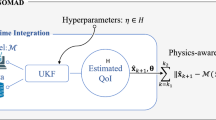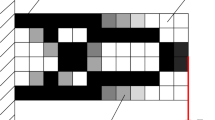Abstract
An extension to the divide-and-conquer algorithm (DCA) is presented in this paper to model constrained multibody systems. The constraints of interest are those applied to the system due to the inverse dynamics or control laws rather than the kinematically closed loops which have been studied in the literature. These imposed constraints are often expressed in terms of the generalized coordinates and speeds. A set of unknown generalized constraint forces must be considered in the equations of motion to enforce these algebraic constraints. In this paper dynamics of this class of multibody constrained systems is formulated using a Generalized-DCA. In this scheme, introducing dynamically equivalent forcing systems, each generalized constraint force is replaced by its dynamically equivalent spatial constraint force applied from the appropriate parent body to the associated child body at the connecting joint without violating the dynamics of the original system. The handle equations of motion are then formulated considering these dynamically equivalent spatial constraint forces. These equations in the GDCA scheme are used in the assembly and disassembly processes to solve for the states of the system, as well as the generalized constraint forces and/or Lagrange multipliers.









Similar content being viewed by others
References
Anderson, K.S.: Recursive derivation of explicit equations of motion for efficient dynamic/control simulation of large multibody systems. Ph.D. thesis, Stanford University (1990)
Armstrong, W.W.: Recursive solution to the equations of motion of an n-link manipulator. In: Fifth World Congress on the Theory of Machines and Mechanisms, vol. 2, pp. 1342–1346 (1979)
Artemova, S., Grudinin, S., Redon, S.: Fast construction of assembly trees for molecular graphs. J. Comput. Chem. 32, 1589–1598 (2011)
Avello, A., Jimenez, J.M., Bayo, E., Garsia de Jalón, J.: A simple and highly parallelizable method for real-time dynamic simulation based on velocity transformations. Comput. Methods Appl. Math. 107(3), 313–339 (1993)
Bae, D.S., Haug, E.J.: A recursive formation for constrained mechanical system dynamics. Part I. Open loop systems. Mech. Struct. Mach. 15(3), 359–382 (1987)
Bae, D.S., Kuhl, J.G., Haug, E.J.: A recursive formulation for constrained mechanical system dynamics. Part III. Parallel processor implementation. Mech. Based Des. Struc. 16(2), 249–269 (1988)
Bhalerao, K.D., Critchley, J., Anderson, K.S.: An efficient parallel dynamics algorithm for simulation of large articulated robotic systems. Mech. Mach. Theory 53, 86–98 (2012)
Bhalerao, K.D., Poursina, M., Anderson, K.S.: An efficient direct differentiation approach for sensitivity analysis of flexible multibody systems. Multibody Syst. Dyn. 23(2), 121–140 (2010)
Brandl, H., Johanni, R., Otter, M.: A very efficient algorithm for the simulation of robots and similar multibody systems without inversion of the mass matrix. In: IFAC/IFIP/IMACS Symposium, Vienna, Austria, pp. 95–100 (1986)
Chung, S., Haug, E.J.: Real-time simulation of multibody dynamics on shared memory multiprocessors. J. Dyn. Syst. Meas. Control 115, 627–637 (1993)
Critchley, J.H., Anderson, K.S.: Parallel logarithmic order algorithm for general multibody system dynamics. Multibody Syst. Dyn. 12(1), 75–93 (2004)
Haug, P.H.E.: Second-order design sensitivity analysis of mechanical system dynamics. Int. J. Numer. Methods Eng. 18, 1699–1717 (1982)
Featherstone, R.: The calculation of robotic dynamics using articulated body inertias. Int. J. Robot. Res. 2(1), 13–30 (1983)
Featherstone, R.: Robot Dynamics Algorithms. Kluwer Academic, New York (1987)
Featherstone, R.: A divide-and-conquer articulated body algorithm for parallel O(log(n)) calculation of rigid body dynamics. Part 1. Basic algorithm. Int. J. Robot. Res. 18(9), 867–875 (1999)
Featherstone, R.: A divide-and-conquer articulated body algorithm for parallel O(log(n)) calculation of rigid body dynamics. Part 2. Trees, loops, and accuracy. Int. J. Robot. Res. 18(9), 876–892 (1999)
Fijany, A., Bejczy, A.K.: Techniques for parallel computation of mechanical manipulator dynamics. Part II. Forward dynamics. In: Leondes, C. (ed.) Advances in Robotic Systems and Control, vol. 40, pp. 357–410. Academic Press, San Diego (1991)
Fijany, A., Sharf, I., D’Eleuterio, G.M.T.: Parallel O(logn) algorithms for computation of manipulator forward dynamics. IEEE Trans. Robotic. Autom. 11(3), 389–400 (1995)
Hwang, R.S., Bae, D., Kuhl, J.G., Haug, E.J.: Parallel processing for real-time dynamics systems simulations. J. Mech. Des. 112(4), 520–528 (1990)
Jain, A.: Unified formulation of dynamics for serial rigid multibody systems. J. Guid. Control Dyn. 14(3), 531–542 (1991)
Jain, A., Vaidehi, N., Rodriguez, G.: A fast recursive algorithm for molecular dynamics simulation. J. Comput. Phys. 106(2), 258–268 (1993)
Kane, T.R., Levinson, D.A.: Dynamics: Theory and Application. McGraw-Hill, New York (1985)
Kasahara, H., Fujii, H., Iwata, M.: Parallel processing of robot motion simulation. In: Proceedings IFAC 10th World Conference (1987)
Kreutz-Delgado, K., Jain, A., Rodriguez, G.: Recursive formulation of operational space control. Int. J. Robot. Res. 11(4), 320–328 (1992)
Lathrop, L.H.: Parallelism in manipulator dynamics. Int. J. Robot. Res. 4(2), 80–102 (1985)
Luh, J.S.Y., Walker, M.W., Paul, R.P.C.: On-line computational scheme for mechanical manipulators. J. Dyn. Syst. Meas. Control 102, 69–76 (1980)
Malczyk, P., Fraczek, J.: Lagrange multipliers based divide and conquer algorithm for dynamics of general multibody systems. In: Proceedings of the ECCOMAS Thematic Conference—Multibody Systems Dynamics, Warsaw, Poland (2009)
Malczyk, P., Janusz Fraczek, J.C.: Parallel index-3 formulation for real-time multibody dynamics simulations. In: Proceedings of the 1st Joint International Conference on Multibody System Dynamics, Lappeenranta, Finland (2010)
Mráz, L., Valášek, M.: Solution of three key problems for massive parallelization of multibody dynamics. Multibody System Dynamics, 1–19
Mukherjee, R., Anderson, K.S.: A logarithmic complexity divide-and-conquer algorithm for multi-flexible articulated body systems. Comput. Nonlinear Dyn. 2(1), 10–21 (2007)
Mukherjee, R., Anderson, K.S.: An orthogonal complement based divide-and-conquer algorithm for constrained multibody systems. Nonlinear Dynam. 48(1–2), 199–215 (2007)
Mukherjee, R.M., Anderson, K.S.: Efficient methodology for multibody simulations with discontinuous changes in system definition. Multibody Syst. Dyn. 18, 145–168 (2007)
Mukherjee, R.M., Bhalerao, K.D., Anderson, K.S.: A divide-and-conquer direct differentiation approach for multibody system sensitivity analysis. Struc. Multidiscip. Optim. 35, 413–429 (2007)
Mukherjee, R.M., Crozier, P.S., Plimpton, S.J., Anderson, K.S.: Substructured molecular dynamics using multibody dynamics algorithms. International Journal of Non-Linear Mechanics: Nonlinear Mechanics and Dynamics of Macromolecules (2007)
Neilan, P.E.: Efficient computer simulation of motions of multibody systems. Ph.D. thesis, Stanford University (1986)
Poursina, M., Anderson, K.S.: Constant temperature simulation of articulated polymers using divide-and-conquer algorithm. In: Proceedings of the ECCOMAS Thematic Conference—Multibody Systems Dynamics, Brussels, Belgium (2011)
Poursina, M., Anderson, K.S.: Multibody dynamics in generalized divide and conquer algorithm (GDCA) scheme. In: Proceedings of the Eighths International Conference on Multibody Systems, Nonlinear Dynam. and Control, ASME Design Engineering Technical Conference 2011 (IDETC11), Washington, DC, pp. DETC2011–DETC48383 (2011)
Poursina, M., Bhalerao, K.D., Flores, S., Anderson, K.S., Laederach, A.: Strategies for articulated multibody-based adaptive coarse grain simulation of RNA. Methods Enzymol. 487, 73–98 (2011)
Roberson, R.E., Schwertassek, R.: Dynamics of Multibody Systems. Springer, Berlin (1988)
Rosenthal, D.: An order n formulation for robotic systems. J. Astronaut. Sci. 38(4), 511–529 (1990)
Rosenthal, D.E., Sherman, M.A.: High performance multibody simulations via symbolic equation manipulation and Kane’s method. J. Astronaut. Sci. 34(3), 223–239 (1986)
Rossi, R., Isorce, M., Morin, S., Flocard, J., Arumugam, K., Crouzy, S., Vivaudou, M., Redon, S.: Adaptive torsion-angle quasi-statics: a general simulation method with applications to protein structure analysis and design. Bioinformatics 23(13), 408–417 (2007)
Shabana, A.A.: Dynamics of Multibody Systems, 2nd edn. Cambridge University Press, Cambridge (1998)
Vaidehi, N., Jain, A., Goddard, W.A.: Constant temperature constrained molecular dynamics: the Newton–Euler inverse mass operator method. J. Phys. Chem. 100(25), 10,508–10,517 (1996)
Vereshchagin, A.F.: Computer simulation of the dynamics of complicated mechanisms of robot-manipulators. Eng. Cybern. 12(6), 65–70 (1974)
Walker, M.W., Orin, D.E.: Efficient dynamic computer simulation of robotic mechanisms. J. Dyn. Syst. Meas. Control. 104, 205–211 (1982)
Acknowledgements
Support for this work received under National Science Foundation through award No. 0757936 is gratefully acknowledged. The author would like to thank Mr. Michael Sherman from Simbios Center at Stanford University for several useful discussions.
Author information
Authors and Affiliations
Corresponding author
Rights and permissions
About this article
Cite this article
Poursina, M., Anderson, K.S. An extended divide-and-conquer algorithm for a generalized class of multibody constraints. Multibody Syst Dyn 29, 235–254 (2013). https://doi.org/10.1007/s11044-012-9324-9
Received:
Accepted:
Published:
Issue Date:
DOI: https://doi.org/10.1007/s11044-012-9324-9




